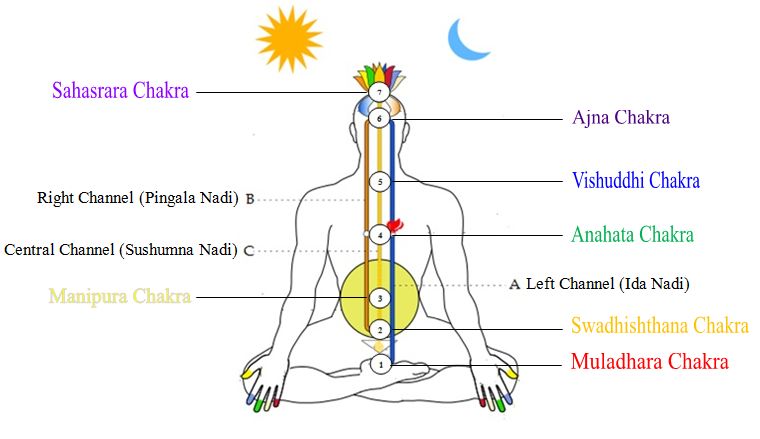Knowledge of Self – Chakras and Nadis

In our last discussion of The Yoga Sutras of Patanjali, we discussed three more sutras that have to do with knowledge of the nadis and chakras (energy lines and centers) and the ability for that knowledge and integration (samyama) to bring control over certain bodily functions.
The navel (nabhi or manipuraka chakra) is known as the kandasthana, the egg or the root, of all other nerves within the body. Full knowledge and integration on the navel area is said to bring “perfect knowledge of the disposition of the human body” (Sutra III.30). Current scientific studies concur with the ancient yogis that the gut and the workings of the intestines are the root of much of the rest of the body’s health, including the brain and mental function. We had a lively discussion of how if we are paying close attention to the gut and how it is working/feeling that it brings clues to our overall health. It is a reminder that though we are in this Third Chapter of “naturally super” powers acquired by a yogi, even in the beginning stages of asana, we are becoming more and more sensitive to the workings of our body, the knowledge of our Self.
The next couple of sutras in our discussion dealt with the area of the pit of the throat – controlling hunger and thirst (visuddhi chakra) and gaining the ability to remain physically and mentally stable as a tortoise (kurma nadi). Though the kurma nadi’s exact location within the human system has been lost, what we do know is that it connects to the epigastric region of the body, and when controlled gives us the power of hibernation, drawing us away from external distraction and disturbance. A quote from BKS Iyengar’s translation and commentary, Light on the Yoga Sutras of Patanjali states “One’s mental functions revolve mainly around lust, anger, greed, infatuation, pride and envy, considered the enemies of the soul. They are represented by the four legs, mouth and tail of the tortoise. The tortoise draws its head and limbs into the shell and does not come out, come what may. By mastery over the kurma nadi, the yogi stops the movements of these six spokes of the mind…”
This control over our bodily functions of course gives us more control over our mental functions, and in the commentary of III.30, BKS Iyengar also reminds us that “Only the yogi can know the fine dividing live between body and mind, mind and soul, and become master of the self”. This is why for me this subject is endlessly fascinating. We can have a very literal discussion of bowel movements occurring in the area of the navel and know that somewhere along the line, that sensitivity and knowledge will also connect us to something deeper on some layer of the Self. Complete knowledge means complete knowledge – not shying away from the uncomfortable or the gross. We carry all of it within us.
For our next discussion on FEB 6th, we will read the next three sutras in the Third Chapter, continuing the knowledge and integration of the chakras. The sutra translations below are all from BKS Iyengar’s book Light on the Yoga Sutras of Patanajali:
III.33 – By performing samyama (integration) on the light of the crown of the head (ajna chakra), the yogi has visions of perfected beings.
III.34 – Through the faculty of spiritual perception the yogi becomes the knower of all knowledge.
III.35 – By samyama on the region of the heart (anahata chakra), the yogi acquires a thorough knowledge of the contents and tendencies of consciousness.
Things to think about in the next weeks before discussion:
- What does “perfected being” bring to mind? Do you have guides or teachers or things you look to for spiritual guidance?
- The ajna chakra is known as the “third eye” – are there things within yoga that have given you “clearer vision” or “sight of your self”?
- The heart space is thought to be the place where our purusa (soul/spirit) resides – are you more apt to act from your head or act from your heart? Why or why not?
- We also know that our heart space is a place of feeling – how do we expose that space or protect it?
- Does “tapping into the source of your being” feel scary or profound? Where does your true identity live for you?
Our Yoga Sutra Discussion Group will meet on the FIRST SUNDAY of each month in 2022. It is a discussion based group, so even if you have missed some or are just joining in, each discussion is facilitated with recaps and needed review. Please join us on Feb 6th at 11:00am (CST) – this is an online ZOOM offering only.